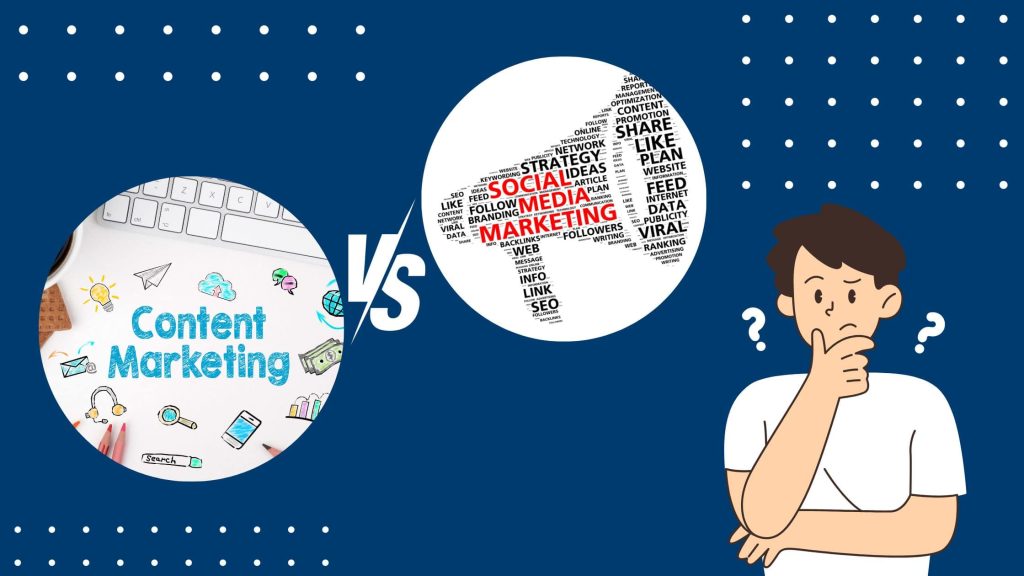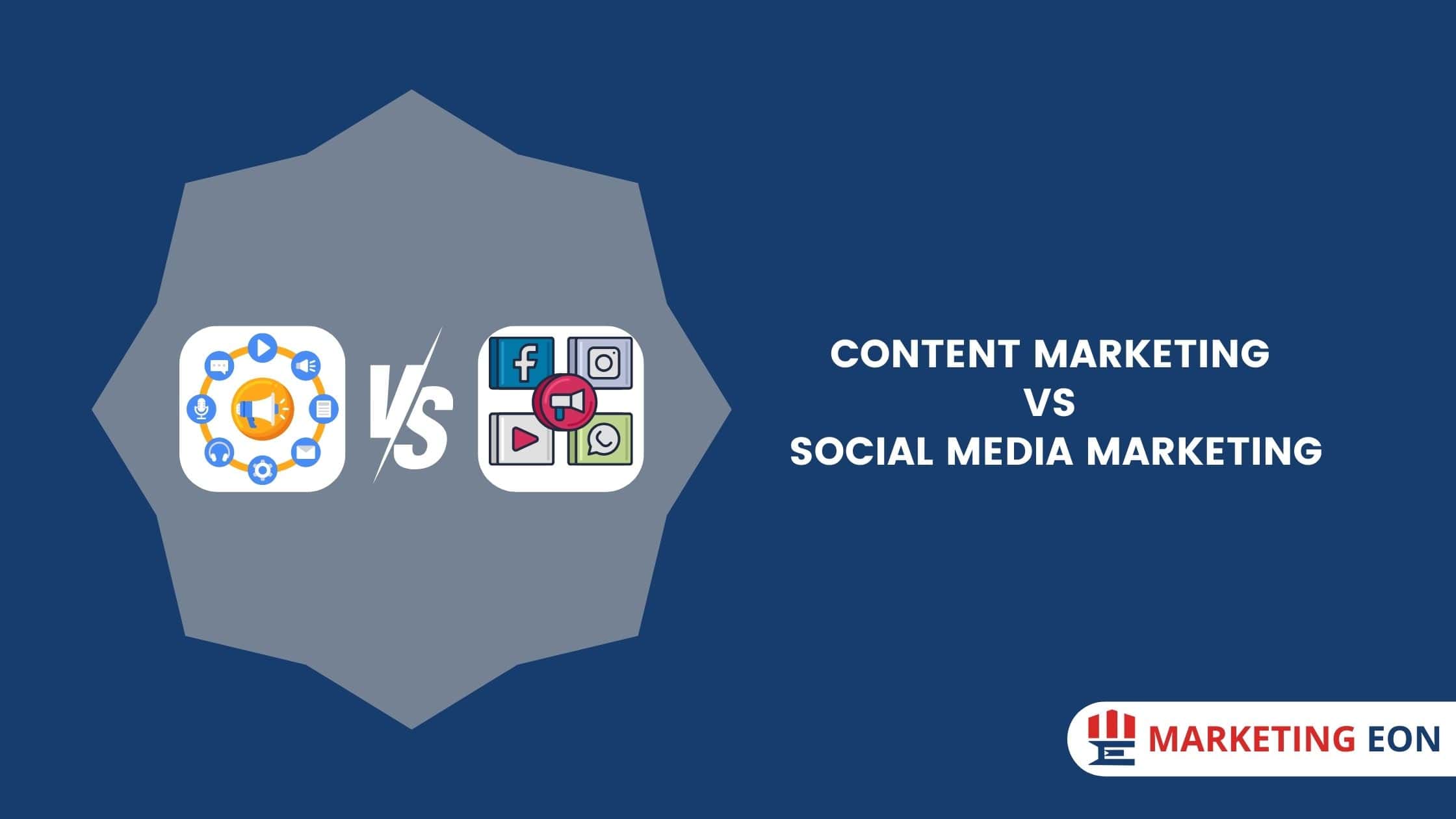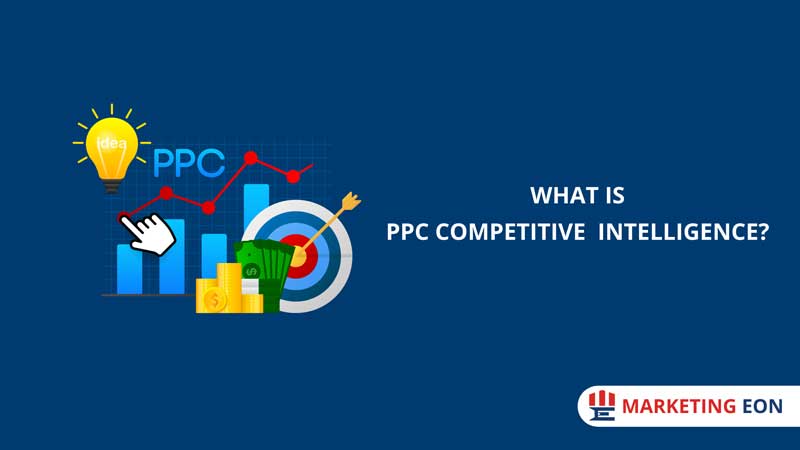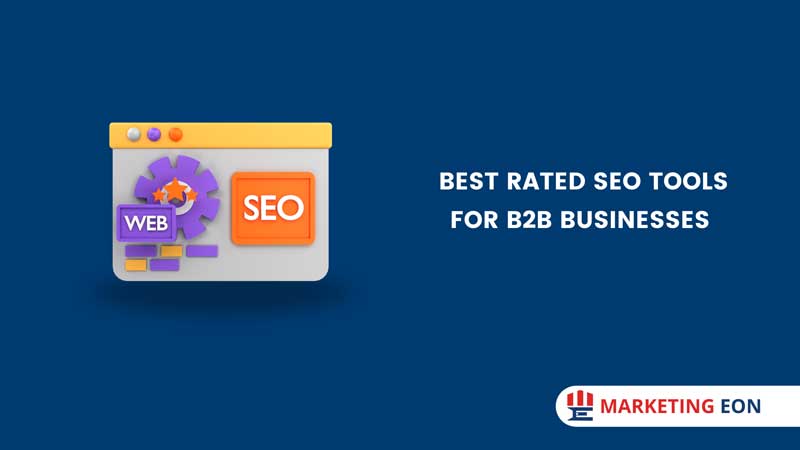There has been an ongoing misconception about “Content Marketing vs Social Media Marketing” where people use or misunderstand these terms interchangeably. They have unique features that distinguish them from each other. As a marketer, you need to know the differences between content marketing and social media marketing to use them appropriately for your business needs.
In this digital business world, these two popular forms of marketing stand out as powerful tools for engaging audiences and driving results. While both approaches share common goals of building brand awareness, increasing engagement, and driving conversions, their tactics, objectives, and outcomes differ.
Here, we will explore the key differences between content marketing and social media marketing and learn more about their unique features so that you can determine which strategy is right for your business.
Overview of Content Marketing vs Social Media Marketing
What is Content Marketing?
In easy words, content marketing means making and sharing valuable, engaging content to get and keep people interested. It’s not like regular ads that interrupt you; it’s about giving helpful info or fun things. The aim is to build trust, show you know your stuff, and get people to do things that benefit your business.
In other words, Content marketing is a marketing strategy that revolves around creating and disseminating valuable, pertinent, and coherent content aimed at capturing and retaining a specific audience.
Key Features of Content Marketing
1. Valuable Content Creation: Creating high-quality, relevant, and valuable content that addresses the needs, interests, and pain points of your audiences is the main feature of Content marketing. The content can be different, such as blog posts, articles, videos, infographics, podcasts, and eBooks.
2. Audience-Centric Approach: Content marketing focuses on understanding the audience and creating content that resonates with their preferences, challenges, and aspirations. Content marketers can build trust, credibility, and loyalty over time by catering to the audience’s needs.
3. Consistent Publishing: Consistency is key in content marketing. Regularly publishing fresh and engaging content helps maintain audience interest and keeps them returning for more. Whether it’s daily blog posts, weekly videos, or monthly newsletters, consistency ensures a steady flow of content to engage the audience.
4. Multi-Channel Distribution: Content marketing involves distributing content across various channels to reach a wider audience. This includes owned channels such as websites, blogs, and email newsletters, as well as external channels like social media platforms, guest blogs, and industry publications.
5. Search Engine Optimization (SEO): Content marketing and SEO go hand in hand. Creating optimized content incorporating relevant keywords, meta tags, and internal linking strategies helps improve search engine rankings and drive organic traffic to the website.
6. Engagement and Interaction: Content marketing encourages engagement and interaction with the audience. Whether it’s through comments on blog posts, shares on social media, or responses to email newsletters, fostering two-way communication helps build relationships and community around the brand.
7. Measurement and Analysis: Content marketing involves tracking and analyzing key metrics to evaluate the performance of content efforts. Metrics such as website traffic, engagement rates, conversion rates, and lead generation help content marketers assess the effectiveness of their strategies and make data-driven decisions for improvement.
Examples of Content Marketing
- Blog Posts: A company in the fitness industry may create blog posts offering workout tips, nutrition advice, and motivational content to attract fitness enthusiasts and position itself as an authority in the space.
- Video Tutorials: A software company may produce videos demonstrating how to use their product features, helping users get the most out of their software while showcasing its capabilities.
- Social Media Campaigns: A clothing brand may launch a social media campaign featuring user-generated content from customers wearing their products, encouraging engagement and fostering a sense of community among followers.
- Ebooks and Whitepapers: A B2B technology company may publish ebooks and whitepapers offering in-depth insights and analysis on industry trends, helping to position the company as a thought leader and generate leads from interested prospects.
- Podcasts: A marketing agency may produce a podcast series featuring interviews with industry experts and discussions on marketing trends and strategies, providing valuable insights and building credibility within the marketing community.
How to Perform Content Marketing Strategically
- Define Clear Objectives: Businesses must define clear and specific objectives before implementing content marketing. Whether the goal is to increase brand awareness, drive website traffic, generate leads, or boost sales, having well-defined objectives ensures that the content marketing efforts are aligned with the overall business goals.
- Understand the Target Audience: To create content that resonates with the audience, businesses must have a deep understanding of their target audience’s preferences, interests, needs, and pain points. Conducting market research, analyzing customer data, and creating buyer personas can help businesses identify the topics, formats, and channels that best engage their audience.
- Develop a Content Strategy: A comprehensive content strategy outlines the types of content to create, the channels to distribute it on, and the publishing schedule. It should include a mix of content formats, such as blog posts, videos, infographics, eBooks, podcasts, and more, tailored to the target audience’s preferences. Additionally, the content strategy should incorporate keyword research and SEO best practices to ensure the content is optimized for search engines.
- Create High-Quality Content: Content marketing success hinges on creating high-quality, valuable, relevant content that resonates with the audience. Businesses should strive to provide informative, entertaining, or inspiring content that addresses the needs and interests of their target audience. Content should be well-researched, well-written, visually appealing, and optimized for readability and shareability.
- Diversify Content Distribution Channels: To reach a wider audience and maximize the impact of content marketing efforts, businesses should distribute their content across various channels. This includes owned channels such as websites, blogs, and email newsletters, as well as external channels such as social media platforms, guest blogs, industry publications, and online communities.
- Promote and Amplify Content: Creating great content is only half the battle; businesses must promote and amplify their content to ensure it reaches the intended audience. This can involve sharing content on social media, promoting it through email newsletters, engaging with influencers, participating in online communities, and running paid advertising campaigns.
- Measure and Analyze Results: To evaluate the effectiveness of content marketing efforts, businesses must regularly measure and analyze key performance metrics. This includes tracking metrics such as website traffic, engagement rates, conversion rates, leads generated, and ROI. By analyzing these metrics, businesses can identify what’s working well and what areas need improvement, allowing them to refine their content strategy for better results.
- Iterate and Optimize: Content marketing is an ongoing process that requires continuous refinement and optimization. Based on the insights gained from performance metrics, businesses should iterate on their content strategy, experimenting with different content formats, distribution channels, and messaging to find what resonates best with their audience. By continuously testing, learning, and optimizing, businesses can ensure that their content marketing efforts remain effective and impactful.
What is Social Media Marketing
Social media marketing is when you use social media sites to talk to your audience, make people know about your brand, get more people to visit your website, and, in the end, sell more stuff. You do this by posting and sharing things on sites like Facebook, Instagram, Twitter, LinkedIn, and Pinterest to talk to your followers, show off your products or services, and meet your business goals.
Key Features of Social Media Marketing
- Precise Targeting: Social media platforms provide sophisticated targeting options, enabling businesses to tailor their ads to specific demographics, interests, and behaviours. This precision ensures marketing efforts reach the most relevant audience, enhancing campaign effectiveness.
- Engagement Opportunities: Social media facilitates direct engagement between businesses and their audience through likes, comments, shares, and messages. These interactions foster stronger relationships, bolster brand loyalty, and increase customer satisfaction.
- Brand Visibility: With expansive reach, social media platforms are powerful tools for boosting brand awareness. Consistent posting, engaging content, and targeted advertising help businesses expand their audience and reinforce brand recognition.
- Customer Insights: Social media offers valuable insights into customer preferences, opinions, and behaviours. Businesses gain valuable data to improve products and services and enhance customer experiences by monitoring feedback, comments, and mentions.
- Content Distribution: Businesses leverage social media to distribute various content formats, including blog posts, videos, and promotions. This enables them to increase content visibility and get more traffic to their digital channels, such as websites or landing pages.
- Real-Time Communication: Social media enables businesses to engage with customers in real time, providing immediate responses to inquiries and feedback. This transparent and authentic communication builds trust and strengthens customer relationships.
- Performance Analysis: Social media platforms offer robust analytics tools to track campaign performance. By monitoring metrics like engagement, reach, and conversions, businesses can assess whether their strategies are working and make adjustments to optimize results.
Examples of Social Media Marketing
- Facebook Advertising: A retail brand may run Facebook ads showcasing its latest products to target audiences based on demographics, interests, and online behavior.
- Instagram Influencer Partnerships: A beauty brand may collaborate with influencers on Instagram to promote their products to their followers through sponsored posts or stories.
- Twitter Customer Service: A telecommunications company may use Twitter to provide customer support and address customer inquiries and complaints in real time.
- LinkedIn Thought Leadership: A B2B software company may share industry insights, tips and tricks, case studies, and thought leadership articles on LinkedIn to establish credibility and attract leads.
- Pinterest Product Pins: An e-commerce store may use Pinterest to get more purchase-intended traffic to their website and increase sales by showcasing visually appealing product pins.
How to Perform Social Media Marketing Strategically
- Set Clear Goals and Objectives: Like any other marketing plan, you need to know what you want and how you will do it before starting your social media marketing. When you have a clear goal and objective, performing social media marketing activities for your business will be easier.
- Identify Target Audience: Every business’s target audiences are different, and you must determine your target audience. Conducting audience research to identify demographics, interests, behaviors, and pain points helps tailor content and messaging to resonate with the intended audience. Creating detailed buyer personas can aid in crafting targeted content that appeals to specific audience segments.
- Choose the Right Platforms: There are better decisions than all the available platforms. Instead, pick one or two platforms where your target audiences spend their time. Whether it’s Facebook, Instagram, Twitter, LinkedIn, Pinterest, or others, selecting the right platforms ensures that social media marketing efforts reach the intended audience effectively.
- Develop a Content Strategy: I always suggest making a well-defined and written content strategy where you will mention everything in detail, such as the types, frequency, and tone of the content. Content should be varied and engaging, including text, images, videos, infographics, and interactive content. The content strategy should also incorporate themes, campaigns, and hashtags to maintain consistency and relevance across posts.
- Engage and Interact with the Audience: Social media is inherently social, and businesses should actively engage with their audience by responding to comments, messages, and mentions promptly. Encouraging conversations, asking questions, and soliciting feedback fosters meaningful interactions and builds relationships with followers. Additionally, sharing user-generated content and featuring customer testimonials can enhance engagement and trust.
- Utilize Paid Advertising: While organic reach on social media is valuable, businesses can amplify their reach and visibility through paid advertising. Social media platforms offer robust advertising options, including sponsored posts, targeted ads, and promoted content, allowing businesses to reach the exact targeted audiences. Paid advertising can complement organic efforts and drive desired actions such as website visits, app installs, or product purchases.
- Monitor and Analyze Performance: Monitoring social media performance metrics is necessary for a marketer because it will help you navigate your marketing plan. You should constantly track the key metrics such as engagement rate, reach, impressions, click-through rate, conversion rate, and return on investment (ROI). Analyzing these metrics provides insights into what content resonates with the audience, which platforms drive the most traffic, and where adjustments are needed to optimize performance.
- Iterate and Optimize: Social media marketing is an iterative process that requires continuous refinement and optimization. Based on performance insights, businesses should iterate on their content strategy, experiment with different formats and messaging, and refine targeting criteria to improve results over time. Businesses can boost their outcomes through social media marketing by testing, learning, and optimising.
Is Content Marketing and Social Media Marketing Same?
You must have heard the question already; I believe you know the answer now. There are so many differences between “content marketing vs social media marketing”, yet they are often used interchangeably. While they share some similarities and can complement each other, they serve distinct purposes and employ different strategies. Now, we will see the breakdown of their differences.

Difference between Content Marketing vs Social Media Marketing
| Aspect | Content Marketing | Social Media Marketing |
|---|---|---|
| Focus and Purpose | Provides valuable content to attract and retain audience, driving profitable actions | Connects with audience, builds brand awareness, drives engagement and conversions |
| Content Format | Blog posts, articles, videos, infographics, eBooks, whitepapers | Posts, stories, images, videos, live broadcasts |
| Distribution Channels | Owned channels (websites, blogs, email newsletters), external channels (social media, guest blogs, industry publications) | Social media platforms (Facebook, Instagram, Twitter, LinkedIn, Pinterest) |
| Audience Interaction | Comments, shares, discussions on content pieces | Likes, comments, shares, messages, live interactions |
| Goals and Objectives | Provides value, builds brand authority, drives profitable actions | Increases brand awareness, fosters engagement, drives specific actions through social media |
| Measurement and Analytics | Metrics like website traffic, engagement rates, lead generation, conversion rates | Metrics such as engagement rate, reach, impressions, click-through rate, conversion rate, ROI specific to social media platforms |
Choosing the Right Strategy: Content Marketing vs Social Media Marketing
So, which strategy should you choose for your business? The answer depends on various factors, including your goals, target audience, resources, and industry. There is no one-size-fits-all answer when choosing between content marketing and social media marketing. Instead, businesses must consider their unique goals, target audience, resources, and industry dynamics to determine which strategy aligns best with their objectives.
- Content Marketing: Ideal for businesses looking to establish authority, provide value, and drive organic traffic through high-quality content creation and distribution. Content marketing is well-suited for businesses in industries where the audience values in-depth information and expertise.
- Social Media Marketing: Suitable for businesses looking to increase brand visibility, foster engagement, and drive specific actions through social media platforms. Social media marketing is particularly effective for businesses targeting a younger demographic or industries where visual content and real-time interactions resonate with the audience.
The Power of Integration: Content Marketing vs Social Media Marketing
While content marketing and social media marketing offers distinct benefits, the most effective marketing strategies often involve integration and synergy between the two approaches. By combining valuable content creation with strategic social media distribution, businesses can maximize their reach, engagement, and conversion potential in the digital world.
Conclusion
After reading the guide “Content Marketing vs social media marketing“, you must have a clear idea about these marketing forms and how to use them in your business. You can take professional services if you do not know how to implement these marketing strategies in your business.
You can take content marketing, social media marketing services or both from a professional service provider and enjoy your business growth potential. By understanding the differences between the two approaches and leveraging their strengths, you can take your marketing game to the next level as a marketer.
You may also read: How Content Marketing is Changing the Game






